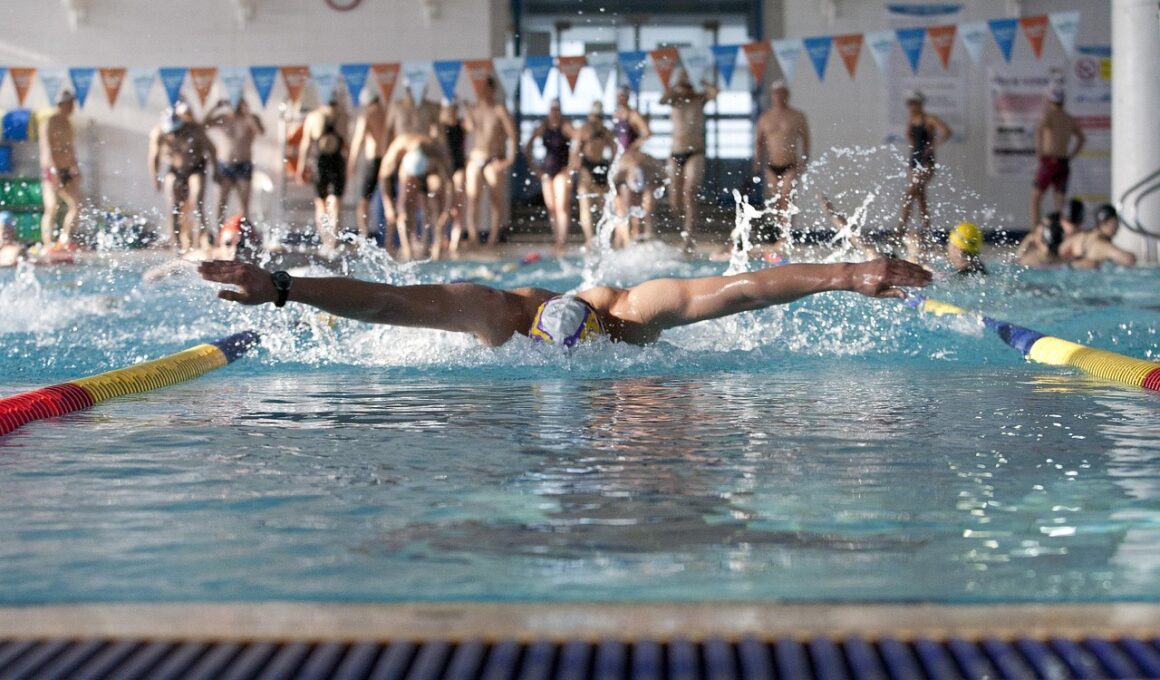Swimming Exercises to Enhance Flexibility for Arthritis Patients
Swimming is highly beneficial for arthritis patients due to its low-impact nature. It allows individuals to exercise without putting excessive strain on their joints. Water’s buoyancy supports the body, helping to alleviate the pain associated with movement. One of the most effective swimming exercises for enhancing flexibility is the flutter kick. When performed regularly, this exercise promotes hip flexibility and leg strength. Additionally, arm strokes, such as the freestyle and breaststroke, encourage upper body flexibility and mobilization of the shoulders. Furthermore, integrating water aerobic classes can provide a structured approach to improving flexibility and overall fitness in a supportive environment. These classes often incorporate varied movements that enhance the range of motion in joints. Notably, water resistance plays a vital role as it can increase muscle strength over time while promoting joint flexibility simultaneously. Moreover, stretching exercises within the water significantly reduce the likelihood of injury. Participating in regular swimming routines can make a substantial difference in managing arthritis symptoms. In summary, swimming is an excellent method for increasing flexibility while maintaining joint health for arthritis patients.
Benefits of Swimming for Arthritis Sufferers
Engaging in swimming exercises specifically tailored for arthritis patients presents numerous health benefits. The warmth of the water often helps to soothe stiff joints and muscles, which makes swimming feel comfortable. Patients often experience a reduction in inflammation and joint pain through consistent aquatic exercise. This casual yet effective exercise routine bolsters overall physical health and emotional wellbeing. Another advantageous aspect of swimming is its potential to improve cardiovascular fitness without overexerting the body. Enhanced endurance provides individuals with more energy for daily activities. It also fosters mental health benefits as swimming can be a meditative experience, helping to release stress and anxiety. Many arthritis patients also discover that participating in group swimming sessions or water aerobics fosters social interaction, which is vital for mental health. Together with the physical benefits, social engagement in these activities can lead to profound emotional support, contributing to an overall improved quality of life. Hence, swimming serves not just as a means of exercise, but also a holistic approach to better living for arthritis sufferers. In conclusion, swimming is an enriching activity for physical, emotional, and social wellbeing.
One commonly overlooked benefit is the setting of the water. It is inherently healing, cushioning the body while facilitating movement. Gentle stretching exercises in water can augment flexibility significantly. Examples include reaching upward with both arms and performing rotations of the torso. These movements enable a thorough stretch along major muscle groups. Additionally, treading water can build endurance and involves simultaneous use of upper and lower body strength. This exercise further strengthens the core, which stabilizes the spine and enhances balance. Staying consistent with such exercises yields long-term benefits, ultimately reducing stiffness in joints. Water resistance ensures all exercises remain challenging but manageable, making sessions enjoyable. Patients should also incorporate breathing techniques while swimming, as deep breathing can enhance relaxation and efficiency in swimming strokes. Implementing controlled breathing helps to increase lung capacity and oxygen circulation. As a result, patients often experience enhanced physical performance within and outside the pool. Moreover, emotional resilience can strengthen when patients see tangible improvements in their flexibility and pain levels. Continuous participation in swimming initiates a cycle of positivity, motivating arthritis patients to maintain their fitness for improved health outcomes.
Key Techniques for Effective Swimming
For maximum benefit, patients need to employ specific techniques during swimming. Stroke technique plays a crucial role in ensuring effective movement through the water. To enhance flexibility, it is essential to focus on smooth and controlled arm motions. The glide and pull phases of each stroke should be practiced deliberately. Increasing awareness of hand positioning and body alignment is fundamental for optimizing strokes. Moreover, proper leg and core engagement during strokes can contribute to effectively enhancing overall flexibility. Individual exercises might include dolphin kicks and side body rolls, which specifically target flexibility in various muscle groups. Furthermore, maintaining an elongated posture while swimming enhances spinal flexibility and promotes good body mechanics in the water. It’s crucial for patients to receive guidance from experienced instructors. Qualified coaches can provide tailored advice to ensure safe and effective participation in aquatic exercises. They can also recommend modifications based on individual abilities and comfort levels. Therefore, ongoing education about strokes and water-based exercises is paramount for arthritis patients aiming to achieve flexibility and well-being. In summary, mastering swimming techniques enhances the therapeutic effects of swimming for patients.
A vital aspect of swimming for patients with arthritis is the approach to frequency and duration. Beginners should gradually introduce swimming sessions, ideally starting with shorter durations, such as 20-30 minutes. As confidence and stamina grow, the length of sessions can be progressively increased. It’s advisable to swim at least 2-3 times a week for optimal results. This consistent routine helps to develop muscular strength and promote flexibility without causing excessive strain. It is also essential to warm up and cool down properly before and after each session; doing so prepares the body and minimizes the risk of injury. Post-swim stretching can significantly enhance flexibility and support muscle recovery. Stretching exercises performed on the pool deck or in the water help prevent excessive tightness. Hydration should not be overlooked during swimming; although submerged, hydration is crucial for muscle function and endurance. Additionally, paying attention to nutrition plays a vital role in recovery, helping to fuel the body post-exercise. A balanced diet supports muscle development and energy levels, complementing regular swimming efforts. Thus, adopting a holistic approach encompasses training duration, nutrition, and hydration to maximize benefits for arthritis patients.
Community and Support Resources
Joining a community centered around aquatic exercises can profoundly enhance motivation among arthritis patients. In many locations, there are specific groups dedicated to individuals with chronic illnesses seeking to improve their physical health. Local recreation centers often offer classes tailored to those with arthritis, led by trained professionals. Not only do these sessions provide valuable tips, but they also foster friendships with other patients who face similar challenges. Encouraging camaraderie can help participants maintain a consistent routine, making exercise less intimidating and more enjoyable. Furthermore, connecting with peers can provide emotional support, enhancing overall experience and resilience. Online forums and platforms are also useful resources for sharing experiences and seeking advice from fellow patients. Many social media groups focus on arthritis management, where individuals can ask questions and share success stories. Engaging with these communities can provide a sense of belonging, which can significantly improve motivation. Furthermore, advocating for public swimming pools to have specialized programs can contribute to better accessibility for individuals with arthritis. Ultimately, fostering community support and engagement proves essential for perseverance and success in aquatic exercises.
Lastly, embarking on a swimming journey for arthritis patients can be liberating and empowering. Embracing a routine filled with flexibility-enhancing exercises amidst supportive communities promotes both physical and mental health. Through consistent practice, participants notice remarkable improvements in their pain levels and joint mobility. Keeping track of progress ensures patients are aware of their achievements and serves as a motivational tool. Many patients also find joy in setting achievable goals, such as swimming longer distances or mastering new strokes. Setting such goals can act as a focus point, infusing the routine with excitement and purpose. It’s crucial to celebrate successes, whether that’s participating in a virtual challenge or simply enjoying a swim with friends. Many arthritis patients enjoy documenting their journeys through videos or social media, further solidifying their commitment to their physical health. Overall, swimming should be seen as a joyful commitment rather than a chore. This shift in perspective supports emotional wellbeing and nurtures a positive relationship with physical activity. By maintaining an enthusiastic approach and welcoming support, arthritis patients can create a healthy, fulfilling lifestyle through swimming.
The journey of incorporating swimming into one’s routine may present challenges along the way. For some, joining a class or finding a suitable facility may initially prove difficult. However, persistence often leads to rewarding outcomes as the benefits of swimming become apparent. Adequate support and guidance can make this process smoother, encouraging patients to maintain focus. Understanding that discomfort might occur, improvements will be noted over time. It is also essential to listen to one’s body and make necessary adjustments to prevent injury. Establishing a foundation of proper techniques and support networks enhances the overall swimming experience. Moreover, consulting with healthcare professionals, such as physiotherapists, can aid in creating tailored exercise plans specifically for arthritis patients. As challenges arise, remaining open to adapting strategies can play a crucial role in success. Patience and encouragement through setbacks can stimulate motivation and resilience. When faced with obstacles, humor can often lighten the load, bringing joy even to less successful days. Ultimately, the integration of swimming into daily life must be viewed as a journey—one filled with highs and lows, yet rich in opportunities for personal growth and enhancement of wellbeing.


